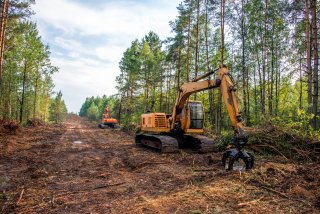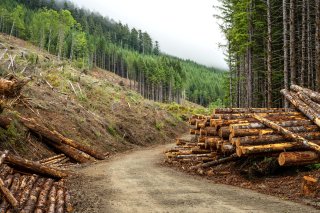Nonpoint Source: Forestry
On this Page:
319 Grants Across the Country: Water Quality Improvements:

Overview:
Sources of nonpoint source (NPS) pollution associated with forestry activities include removal of streamside vegetation, road construction and use, timber harvesting, and mechanical preparation for the planting of trees. Road construction and road use are the primary sources of NPS pollution on forested lands, contributing up to 90 percent of the total sediment from forestry operations. In addition to other water quality impacts, an excessive quantity of sediment in a water body can reduce the ability of aquatic organisms to successfully live, forage, and spawn.
Harvesting trees in the area beside a stream can affect water quality by reducing the streambank shading that regulates water temperature and by removing vegetation that stabilizes the streambanks. These changes can harm aquatic life by limiting sources of food, shade and shelter, as well as decreasing areas suitable for species intolerant of warmer temperatures.

Reports and Guidance Documents
- National Management Measures to Control Nonpoint Source Pollution from Forestry This report helps forest owners protect lakes and streams from polluted runoff that can result from forestry activities. These scientifically sound techniques are the best practices known today. The report will also help states to implement their nonpoint source control programs
- Environmentally Sensitive Maintenance for Dirt and Gravel Roads (pdf)
- Techniques for Tracking, Evaluating, and Reporting the Implementation of Nonpoint Source Control Measures; Forestry (pdf)
- Guidance Specifying Management Measures for Sources of Nonpoint Pollution in Coastal Waters See Chapter 3, Management Measures for Forestry.
- Montana Forestry Practices Program: The Forestry Practices Program leads a biennial field review of the application and effectiveness of BMPs. An audit report is published with the findings.
- Water-Road Interaction Technology Series Documents (2000) This website contains a wealth of resources in helping to manage the impacts of unpaved, low-volume roads on water resources. Topics covered include surface drainage, subsurface drainage, stream crossings, as well as an extensive bibliography of related materials.
Forestry Certification Programs
Forest management certification is evolving rapidly in the United States. Forest management certification arose as a non-regulatory alternative for fostering the improved stewardship of working forestlands. While there are many regulations governing forest management—particularly in the United States—certification provides a private incentive to encourage landowner commitment to sustainable forest management. It also offers a stamp of approval for forest management practices that meet standards considered to be environmentally appropriate, socially beneficial, and economically viable. There are now three major forestry certification programs in the United States:
